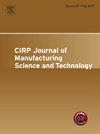准等温热锻和等温滚压成形对变形镍基高温合金显微组织的影响
IF 5.4
2区 工程技术
Q2 ENGINEERING, MANUFACTURING
CIRP Journal of Manufacturing Science and Technology
Pub Date : 2025-08-23
DOI:10.1016/j.cirpj.2025.08.007
引用次数: 0
摘要
本文采用等温滚压成形的新型加工路线,获得了用于燃气涡轮发动机的圆盘工件,并用于后续的圆盘制造。以镍基高温合金Ni-10.3(Al,Ti,Nb)-31.6(Co,Cr,Mo,W) (wt%)(俄文缩写ЭП962)为起始材料。在接收条件下,合金的γ晶粒尺寸约为50 µm。从收到的高温合金中切割出尺寸为Ø200 × 315 mm的钢坯,放入不锈钢罐中。在准等温条件下对钢坯进行了三段亚溶剂锻造和中间退火。最终得到了尺寸约为Ø410 × 75 mm的烧饼。显微组织检查表明,烧饼中部形成了以再结晶为主的细晶组织(d<10 µm),而靠近烧饼平面处则保持了较粗的组织。在滚压成形前,将直径为70 mm的煎饼的中心部分切下,制成小圆柱形试样,在1100℃下进行压缩,改变应变速率,确定应变速率敏感系数m,从而确定超塑性条件。获得的工件就被等温subsolvus附近超塑性条件下辊轧成形1100 T = ± 15°C和έ= 5 × 10−4 - 5 × 10−3 s−1。加工出尺寸约为Ø510 × (35−70)mm的复杂形状圆盘工件。对加工后的盘状工件进行显微组织分析表明,辊压成形后形成了再结晶和梯度组织。平均γ晶粒尺寸从孔区d≈ 9.7 µm到腹板区d≈ 8.8 µm,再到边缘区d≈ 20 µm。讨论了采用该工艺制造燃气涡轮发动机近净形盘的优点。本文章由计算机程序翻译,如有差异,请以英文原文为准。
Effect of quasi-isothermal hot forging and isothermal roll forming on the microstructure of a wrought nickel-based superalloy
In the present work, the novel processing route including isothermal roll forming was applied for obtaining a disc workpiece intended for subsequent manufacturing of a disc, which could be used in gas turbine engines. A wrought nickel-based superalloy Ni-10.3(Al,Ti,Nb)-31.6(Co,Cr,Mo,W) (wt%) (Russian abbreviation ЭП962) was taken as a starting material. In the as-received condition, the superalloy had the microstructure with a γ grain size of about 50 µm. From the as-received superalloy the billet with a size of Ø200 × 315 mm was cut and put into a can made of a stainless steel. The canned billet was subjected to three-stage subsolvus forging under quasi-isothermal conditions with intermediate annealing. As a result, the pancake with a size of about Ø410 × 75 mm was produced. Microstructural examination showed that predominantly recrystallized and fine-grained structure (d<10 µm) was formed in the central part of the pancake, while coarser microstructure was preserved near the flat surfaces of the pancake. Before roll forming, the central part of the pancake with a diameter of 70 mm was cut out and used to make small cylindrical samples, which were compressed at 1100°C with switching of the strain rate to determine the strain rate sensitivity coefficient m and thus the superplastic conditions. The obtained workpiece was then subjected to isothermal subsolvus roll forming under near superplastic conditions at T = 1100 ± 15°C and έ= 5 × 10−4-5 × 10−3 s−1. Complex-shaped disc workpiece with a size of about Ø510 × (35−70) mm was produced. Microstructural analysis of the produced disc workpiece showed that recrystallized and gradient microstructure was formed after roll forming. The average γ grain sizes changed from d≈ 9.7 µm in the bore zone to d≈ 8.8 µm in the web zone and to d≈ 20 µm in the rim zone of the disc workpiece. The advantages of using this processing to manufacture near-net shaped discs for gas turbine engines are discussed.
求助全文
通过发布文献求助,成功后即可免费获取论文全文。
去求助
来源期刊

CIRP Journal of Manufacturing Science and Technology
Engineering-Industrial and Manufacturing Engineering
CiteScore
9.10
自引率
6.20%
发文量
166
审稿时长
63 days
期刊介绍:
The CIRP Journal of Manufacturing Science and Technology (CIRP-JMST) publishes fundamental papers on manufacturing processes, production equipment and automation, product design, manufacturing systems and production organisations up to the level of the production networks, including all the related technical, human and economic factors. Preference is given to contributions describing research results whose feasibility has been demonstrated either in a laboratory or in the industrial praxis. Case studies and review papers on specific issues in manufacturing science and technology are equally encouraged.
 求助内容:
求助内容: 应助结果提醒方式:
应助结果提醒方式:


